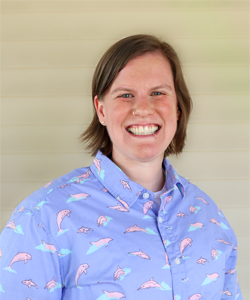Erin Grogan is a PhD candidate in English and a 2021–2022 HRI Graduate Student Fellow. In the post below, they share a glimpse into their fellowship research project, “Queer Futurity and Toxic Temporalities in the Anthropocene.”
As a field, queer theory has long been preoccupied with questions of time and the future. Some theorists argue that queerness and futurity are intimately linked, while others argue that queerness demands a refusal of futurity. Across the spectrum of this debate, a common thread emerges—none of these theorists address the futures we actually face.
In the era of climate crisis, the future feels increasingly bleak. For instance, it’s possible that my hometown will be underwater by 2100. Other people’s hometowns are already underwater, or burned down, or uninhabitable due to environmental racism and disaster. Moving from the local scale to the global, it is clear that climate crisis signals apocalyptic futures.
“My research aims to reconcile this gap between the futures queer theory has imagined and the futures of climate crisis. I bring an environmental humanities analytic to queer theory to conceptualize a queer futurity responsive to environmental destruction.”
I engage environmental humanities strategies by bringing cultural texts about the environment into conversation with queer theoretical texts. In so doing, I re-theorize queer futurity to account for climate change and pollution. My overall intervention is twofold: I argue that the environment must be seen as constitutive of queer futurity, and I posit that our current climatic landscape necessitates a renewed commitment to queer futures.
For example, I explore the oceanic through José Esteban Muñoz’s Cruising Utopia: The Then and There of Queer Futurity. Muñoz defines queerness as both temporal and active; it involves recognizing that the present is not enough and striving toward the future through a critical engagement with hope. He represents this link between queerness and futurity metaphorically, claiming, “queerness is always in the horizon.”[i] In my research, I take Muñoz’s metaphorical contention literally to consider how polluted oceanic horizons shift queer futurity.
I juxtapose Muñoz’s horizon with news accounts from the X-Press Pearl disaster, a horrific shipping incident that spilled approximately seventy-five tons of plastic, twenty-five metric tons of nitric acid, other toxic chemicals, and oil into the ocean. Cultural accounts of the disaster emphasize that the horizon is no longer a locus of hope and futurity; instead, it signals environmental destruction and devastation. Yet, rather than admitting ecological defeat, I turn to Alexis Pauline Gumbs’ meditations on marine mammals to contend that they offer a metaphor for reaching queer futurity. By following Gumbs’ marine mammals’ strategies for community building and navigation, we might locate new horizons of queer futurity in our polluted present.
“Ultimately, my research is about hope and survival. I want to imagine how queerness and queer people might endure and generate creative futures despite the bleak planetary conditions we face.”
Learn more about HRI’s Campus Fellowship program, which supports a cohort of faculty and graduate students through a year of dedicated research and writing in a collaborative, interdisciplinary environment.
[i] José Esteban Muñoz, Cruising Utopia: The Then and There of Queer Futurity (New York: New York University Press, 2009), 11.
